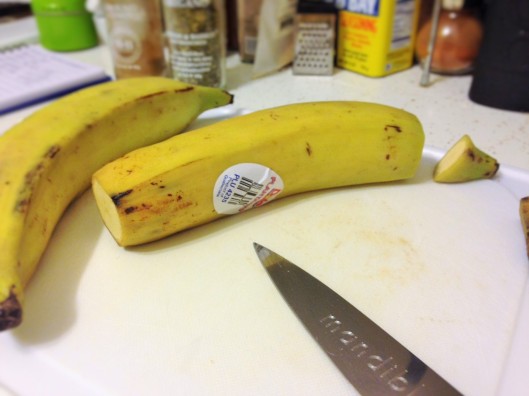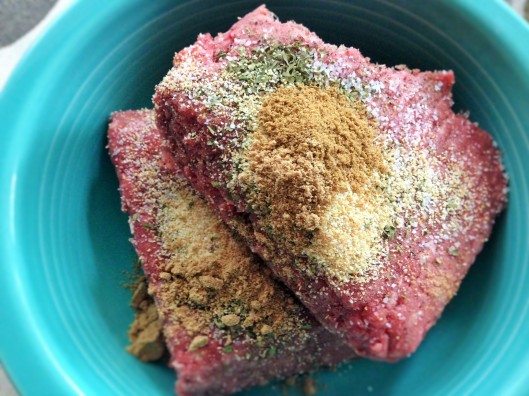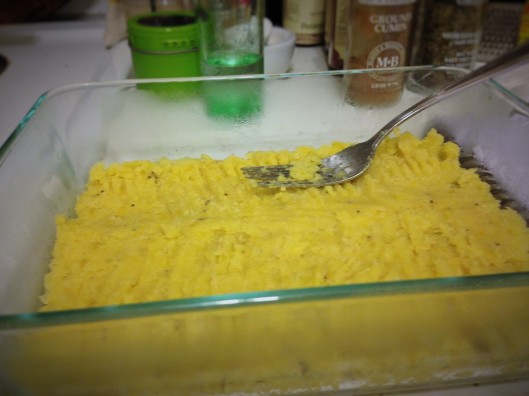Tags
 Here’s something kind of mind-blowing: the fruits that we know as plantains and bananas have been part of the human diet for approximately 10,000 years. That same starchy, yellow breakfast staple you pick up for 79¢ in the produce aisle is believed to have been domesticated around 8,000 BC on the island of New Guinea. That was presumably when people first figured out how to remove the peels without completely mushing up all the goodness inside. Slowly but surely the banana-plantain family made its way across Asia to India and the Middle East. Documents from 327 BC indicate that Alexander the Great came across bananas and plantains while rampaging through India and brought them back west to Europe. And perhaps even before this, plantains and bananas became common in African diets after merchants from Southeast Asia landed in Madagascar and the eastern coast of the continent. Today, Africa supplies the world with more than two-thirds of its plantains, and both bananas and plantains make up as much as a quarter of many diets in the western and central lowland countries. Pretty fascinating, huh? It’s ok to say no. But if the position of food anthropologist exists, someone please direct me towards that job listing.
Here’s something kind of mind-blowing: the fruits that we know as plantains and bananas have been part of the human diet for approximately 10,000 years. That same starchy, yellow breakfast staple you pick up for 79¢ in the produce aisle is believed to have been domesticated around 8,000 BC on the island of New Guinea. That was presumably when people first figured out how to remove the peels without completely mushing up all the goodness inside. Slowly but surely the banana-plantain family made its way across Asia to India and the Middle East. Documents from 327 BC indicate that Alexander the Great came across bananas and plantains while rampaging through India and brought them back west to Europe. And perhaps even before this, plantains and bananas became common in African diets after merchants from Southeast Asia landed in Madagascar and the eastern coast of the continent. Today, Africa supplies the world with more than two-thirds of its plantains, and both bananas and plantains make up as much as a quarter of many diets in the western and central lowland countries. Pretty fascinating, huh? It’s ok to say no. But if the position of food anthropologist exists, someone please direct me towards that job listing.
Of course, plantains are also ubiquitous in Latin American and Caribbean cuisines. Who can say which of the explorers/conquerors from Portugal/Spain first established the crop in the New World, but it obviously caught on quickly. Why? They are nutritious, delicious and very versatile! And pretty economical to grow. They have a higher starch content and less sugar and moisture than bananas so they must be cooked to be enjoyed. If you are new to plantains, find a place that offers the fried, sweet variety (platanos maduros) as an introduction. Just like bananas, plantains become softer and more sugary as they ripen – but don’t be deceived. A yellow plantain is not close to being fully ripened. As I found out while making this week’s dish, you must wait until they are mostly brown for the sweetness to really kick in.
This recipe is adapted from Janet at this Dominican cooking blog. I love constructing a meaty lasagna, and the pastelón de platano maduro (ripe plantain casserole) struck me as something equally hearty and flavorful. And it utilizes the fruit in two different ways, something I rarely get a chance to do. I cut down the quantities quite a bit since I was only serving Matt and I. My one regret: I should have waited another few days to give the plantains a chance to ripen even further. The bunch I used only had a few spots of brown, so that subtle sweetness I was hoping to contrast with the savory flavors of the meat didn’t really come through. Like lasagna, this dish does take awhile to bake so allow yourself plenty of time before you plan to serve. If you are like me, there’s nothing worse than being starving while trying to cut vegetables. I end up eating half of the mise en place.
Pastelón de Platano Maduro (Sweet Plantain Casserol) – Serves 2
1 1/2 lbs. ground beef (you could certainly swap in turkey or chicken if you wanted to cut out some fat)
2 teaspoons salt plus more for seasoning baked plantains
1 teaspoon pepper plus more for seasoning baked plantains
1 teaspoon dried oregano
1 teaspoon garlic powder
1 teaspoon ground coriander
1 teaspoon cumin
4 ripe plantains (should be very brown/tender)
3 cloves garlic, minced
1/2 large onion, diced
1 red bell pepper, diced
1 green bell pepper, diced
1 jalapeño, seeds removed and diced
1 tablespoon tomato paste
2 eggs, well beaten
1-2 tablespoons butter
1 cup cheddar cheese, shredded
1/2 cup vegetable oil
2 tablespoon olive oil
First, season the ground beef with the salt, pepper, oregano, garlic powder, coriander and cumin. You can do this ahead of time and let it sit in the fridge for an hour or two. You could also cut up the vegetables and garlic in the mean time.
Preheat oven to 400°F. Peel two of the plantains and cut each one in half width-wise. The skins are a bit tougher than banana skins so I actually followed Janet’s instructions on the Dominican Flavor blog and used a knife to cut into the plantains at first and then unwrap the peel. Take each half and cut it into slices length-wise, you should get 3-4 slices from each half. Arrange the slices on a cookie sheet (I lined it with aluminum foil so the clean up was easier). In a small bowl or cup, mix 1 tablespoon olive oil with a pinch of salt and pepper. Dab a little of the olive oil mixture on a pastry brush and brush on to one side of the slices. Let bake in oven for about 5 minutes or until the plantains start to brown and get crispy. Turn over and brush the other side with olive oil, then let bake for another 5 minutes. Remove from oven, set aside to cool and decrease oven temperature to 350°F.
For the mashed plantains, fill a medium pot half-way with water and bring to a boil. Peel the other two plantains and cut them into quarters. Place the plantain quarters into the boiling water to soften, 12-15 minutes depending on how ripe they are. I added a pinch of salt to the pot as well. Once you can easily stick a fork through, drain all but a few teaspoons of water from the pot and turn the heat down to low. Add the butter and another pinch of salt, and mash up the plantains until they are a relatively smooth, creamy consistency. Add more butter if you need to and remove from heat.
For the beef mixture, heat up 1 tablespoon olive oil in a large skillet on medium heat. Add the garlic and onions and let soften about 5 minutes. Add the bell peppers and jalapeño and let cook another 5-7 minutes until just starting to soften. Toss in the ground beef, using a spoon or spatula to break it the larger hunks of meat. Cook for 5 minutes, add the tomato paste and then give it another good stir. Cook until the meat is browned completely.
Now time to put this thing together! I used an 8 X 6 X 2 in. Pyrex dish and managed to fit everything in; if you only have a larger one that’s fine but I would recommend mashing another plantain or two for the bottom layer. First pour the mashed plantains into the baking dish and spread into an even layer. Pour the meat and pepper mixture on top of the plantain mash to form the second layer, spreading evenly across the dish. I like Janet’s tip about pressing down the meat with a back of a spoon/spatula – you can definitely pack it in! Then layer the crispy plantain strips over the meat, covering as much of the surface as possible. If you haven’t gotten the eggs out yet and beat them until fluffy, now is a good time. Pour the beaten eggs over the plantains, covering as much of them and the meat as possible. Then go crazy with that shredded cheese! The best part of any dish is always the melted cheese. We all know that by now.
Once the pastelón is covered in cheese, transfer to the oven. Let bake for 30-35 minutes until the cheese is completely melted and begins to form a crust on the plantains. Remove from the oven and let cool for 15-20 minutes before serving. Then dig in!
**There are many variations I found for this recipe, and pretty much all of them involve frying the plantains for the top of the pastelón . I found baking them worked just fine – the crispiness was a great textural contrast to the beef and mashed plantains. Plus logistically it made more sense because I was already using the biggest stove-top pan I have to cook the veggies and the meat. Most recipes also call for Spanish olives to be added to the meat/veggie mixture but tragically my husband is an olive-phobe and can’t go near the things. I also saw raisins used in quite a few cases, and fresh cilantro instead of coriander to season the meat. Hey, go plantains!





I love pastelone! Made with Pica Pollo left-over chicken, some sazon, and cheese …. mium! But, my absolute faves for platanos are of course the tostone, but also ripe plantain, boiled with a wee bit of salt. Oh damn that last one is good, and now … tengo hambre!
Thanks for checking out my blog. I know what you mean, I have to stay away from the internet when I’m starving because I just want to eat every delicious thing I see. I fried up some plantains tonight just to nibble on – the perfect snack!
I’m adding Mediterranean herbs to this 🙂
That sounds delish! Let me know how it turns out 🙂
Sure dear, I’ll let ya know 🙂